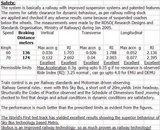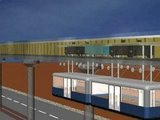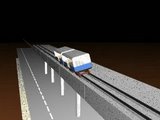CII
Author: Er. B. Rajaram M.Tech., FIE., FNAE
Former MD / Konkan Railway Corporation Ltd.,
Why CII is not taking this opportunity in the interest of industry and our country?
Our attitude for infrasrtructure development
It is cosmic reality that humans are a part and parcel of the universe. They neither own exclusively the resources, nor create any, on their own. A trustee at best, but localised in time and space frame, we cause distortions in access rights causing unequal distribution of wealth. Infrastructure development is the instrument through which the humans address the improvement of quality of life, and knowledge in action is the technology, which forms the driving engine to deliver the infrastructure. Intellect is the precious gift to humans, which used properly, can yield development model, which progressively improves quality of life while reducing the costs of services, thus becoming a wealth generator- wrong approaches currently prevailing, lead to financially unviable models, effectively eroding value and wealth of one community to enrich another exploitative community, which in long term is unsustainable and makes all poorer. Through application of knowledge embedded devices and re-engineering known technologies, it is demonstrated how we can change the pace of infrastructure development to create a win-win strategy of self-sustaining & wealth generating infrastructure, ultimately leading to a situation of virtually free travel, food and dwellings! A real life case of development of the Sky Bus Metro technology in our country is shown to be capable of making the urban transport virtually free with vastly improved quality of service! Such paradigm shift in infrastructure-development is unbelievable, but true!
Sky Bus Metro – a paradigm shift in urban transportation:
The model shows how over 5 to 7 years an urban habitat can virtually have free transportation within their community.
Transport requirements of new economy emerging in the new millennium- Improve quality of life while reducing costs:
- History shows when technologies are outdated they actually become economically un-affordable, typical financial disasters!
- A society which forces their future progeny to pay for today’s comfort is not sustainable
- Today’s transport solutions based on last century’s technologies like elevated/underground rail based systems are violating this cardinal principle-we should not rob wealth of our grand children!
- Human life and quality improvement at reducing costs should be perceived as the focus of the new millennium
- Infrastructure therefore has to cost less but deliver more to be a value generator: technology innovation alone can help
- Sky Bus Metro technology is the break-through in transport technology from our country to cause such paradigm shift to make transport costs to fall while quality of life improves for all including handling cargo – providing a holistic transport solution.
- Urban space remains frozen
- Populations are shifting to urban habitats
- Mass transit capacity
- occupying less and less urban space,
- while being pollution-free
- affordable by common users
- with point to point connectivity
- Be integrated, avoiding inter-modal transfers
- Safer than existing systems-value human life
- Better quality of travel
- Air-conditioned
- Noise-free
- Virtually no-wait service
9.1 Description: Heavy 52/60 kg /m rails placed at standard gauge floating in elastic medium and damped by inertia of measured mass held in a 8 mX 2m box enclosure, supported over a 1m dia. columns spaced at 15 m and located at 15 m distance from each other, in the divider space in between lanes on a road- way, at a height of 8m above road surface- provides the support and guidance for powered bogies which can run at 100 kmph, with the coach shells suspended below , carry passengers in air conditioned comfort, can follow existing road routes, while existing traffic on roads continue.
9.1 The fixed structure at 8 m height above road level is aesthetically pleasing and there is no concern of claustrophobic feeling for road users.
9.2 Aesthetic and eco-friendly, the Sky Bus can never derail, capsize nor collide- by design as well as by construction, hence is safer than existing rail-based system. At Rs 500 m or US$12m/km in India, the system is noise-free and pollution-free with 18000pphpd, scalable to 72000 pphpd as required. With no signalling and having no points and crossings, it is a unique mass-transit system, which can be put up within two years in any crowded & congested city. In addition to moving people Sky Bus system can carry standard 20ft containers, boosting its capacity utilization to double that of other existing systems.
10. Legal provisions: Sky Bus metro falls under tramway category, under Art 366(20) of Constitution of India, since it operates along existing roadways and within municipal limits, hence excluded from Railway Act. However all technologies are railway based and substantially provisions of Railway Act apply with additional provisions required to operate safely in conjunction with road users, who are sharing the transport zone along with the Sky Buses over-head. So a special Sky Bus metro Act has been drafted to cover the legal requirements.
11. The components of SKY BUS
- Sky way
- Sky bogies
- Sky coaches
- Sky stations
- Traverser arrangements at terminals
- In the middle of road way pile foundations support 1 m dia column approximately 8 m high, and space at 15 m all along the roadway
- The sky way consists of a concrete box structure carried over a series of piers at a height of 8 m above existing road level
- Two rails fixed with appropriate fastenings within the concrete box support and guide the sky bogie
- There are no points & crossings-
- Standard two axle bogies used in metros for speeds of 100 kmph are used ( but can have higher speeds, if required up to 160 kmph)- of standard gauge.
- Linear induction motor technology is incorporated-with 4th rail driving which is above the bogie/or 3 Ph AC motors with regenerative power capability.
- Third rail is used for current collection
- Braking-bogie mounted
- Regenerative
- Disc brakes
- Emergency mechanical brakes
Max axle load 12 tonnes
- Weight of bogie-2 axle motor:5 t
- tare weight of coach: 6.5 t
- weight of equipment:2t
- passenger load: 9 t
- total for a bogie: 24 t
- axle load: 12 t
- Double walled light shells with wide large windows are suspended from the sky bogies
- Controlled banking on curves- 100m radius curves can be handled.
- Air conditioned and with automatic doors
- Audio visual information to passengers
- Special 4m wide sliding doors for quick entry and exit of passengers
- Each pair carries 300 persons and service every one minute or 30 seconds is possible.
- Unlike conventional mass transit systems, Sky Bus needs smaller stations
- Service is every 30 seconds or 1 minute that is virtually no waiting time for passengers
- Totally automated without drivers or guards-and access control is also electronic by prepaid cards being swiped in
- Stations act as only access facility, and not as passenger holding area
Proven technologies and a very simple solution by merely re-engineering
the components constitute Sky Bus:
12. Sky Bus: Performance, Costs & Benefits
- Passengers per hour in peak period 40,000 to 80,000 on a route
- Service every minute
- Grid network covers existing roads-point to point service
- Rs 500 m per route km of double line capital cost for 40,000 passengers/hour capacity during peak
- Two years construction period after financial closure.
- Capital can be recovered in 5 to 7 years
- Full private funding possible, being financially viable.
Once the capital is recovered over 5 to 7 years, the residents/occupants, will be entitled for free life-time free travel, for one time payment of Rs 15000.
For a 10km route approximately, 2 lac users , when they pay, funds collected amount to Rs 3000 m. This is used as equity to expand raising debt of twice the amount, which means Rs 10 b worth additional network, providing annual 15% returns. Floating populations continue to be charged, which will be sufficient to pay for the operating expenses. The result is the urban travel becomes virtually free for life at a mere one time payment of 1% of value of his flat!
13. Network of Sky Bus Metro Mumbai city
- Any metro can be sufficiently served by a grid network of 100km route length
- Two routes of 20km length : 40 km
- Four routes across of 10km : 40 km
- Four routes feeders of 5km : 20 km
- About 200 sq.km area can be served!
- The system can move 100,000 to 200,000 passengers per hour in either direction-with flexible transport transfer capacity
- At average lead of 7 km , the system can handle more than 6 m commuters every day assuming utilisation of 50% of capacity!
- The investment is of the order of Rs 600 b for this system and can be up and ready within 3 years! Provides integrated solution, handles cargo too!
- For such service, the current elevated/underground metro systems while being comparatively less safe, cost Rs 1200 b to 2500 b, and also will take not less than 7 to 8 years to construct. Still requires inter-modal transfer costs to be incurred additionally. Pollution of trucks continues in all other transport solutions.
- The innovative concept paper was presented by Mr B. Rajaram at a World Congress on railways at Bolgna University, in the year 1989 titled as ‘ Sky Wheels’.
- After due engineering, the Sky Bus Metro technology was presented by Mr. B. Rajaram as MD Konkan Railway, to the Government of India in the year 2000-2001.
- Dr APJ Abdul Kalam, Scientists like Dr Anil Kakodkar as well as a working Commissioner of Railway Safety affirm technically the system to be feasible and safer than existing systems. (Year-2001)
- Independent consultants like ICRA/ PwC confirm IRR of 14 to 15% (Yr 2001-02)
- Private industries expressed confidence by investing their own funds to put up Rs 7 cr worth Sky Bus prototypes- a miracle by itself!(Yr.2003)
- Then Ministry of Railways authorised Konkan Railway to spend Rs 50 cr to put up 1.6 km test track at Margao-getting ready within the cost to be operated in August 2004.
- Market exists all over the world for the financially viable urban transport
- Even as on date expression of interest cases add up to Rs 500 b- simply based on the concept itself!
- Our country stands to gain from this market as more than 95% is indigenously manufactured.
- Polluted cities causing wasteful fossil fuel consumption being congested lowering average speeds of vehicles, will become wonderful healthy places to attract more investments
- Investment of Rs 500 b over next 5 years covering 1000km of Sky Bus metro in 10 cities can save wasted fossil fuel worth Rs 50 b per annum and improve quality of life for all at affordable price.
- This funding could be fully outside Government resources- private funding possible being financially viable!
- Cement : 5,500,000 MT Steel:2,800,000 MT
- Construction : Rs 150 b Manufacture: Rs 50 b
- Employment :20000 permanent & 200,000 temporary/annum
- Financial services: Rs 15 b Software/devices:Rs 20 b
- Consultancy/design supervisory services: Rs 30 b
- With international market the above figures will be doubled, in 5 years!
17. Skycon, Skyjet & Skyrail technologies
- Sky Bus Metro technologies lead to other transport applications
- Skycon is the application in Ports- the container handling and the Port operations get quantum jump in productivity almost five fold- causes a paradigm shift in designing and operating Ports.
- Skyjet is another application linking major metros bringing the metropolitan cities at 1000 km within travel times of 7 hours! Delivers containers too with the same speed! Hence high speed travel becomes financially viable in our country at affordable prices.
- Skyrail is an application for mountainous areas allowing almost vertical lifts and radius of turning less than 20m, with capability to deliver any defence equipment, free from climatic conditions.
- The scope of all these applications has not been factored in.
- Basically the Skybus Metro System is a modified railway improving the safety parameters: the center of gravity of mass carried by wheels is brought closer to the railway wheel-rail guidance support point as compared to railway. Since we use the same railway bogie on the same railway track used for metros in the world, the same rules for dynamic safety will apply while the system is in motion- that is:
- The peak accelerations in vertical/lateral/longitudinal directions should not exceed the norms fixed for the metro rail systems in the world.
- The ride index values used by Indian railways for their suburban systems used as the upper limits for performance
- Since this is coaching stock with 8 wheel configuration, and limits are based on human comfort, automatically the safety requirement of Derailment Coefficient being within safe limits is assured.
- The above position is confirmed by the Chief Commissioner of Safety for Railways in India.
- The same rules for opening railways can be effectively used in this case too.
- The fixed structure dimensions and the moving dimensions permissible are derived by using the existing clearances provided for rolling stock in our own country. Further from the test track these values can be re-confirmed and validated.
- The principles used for operating and controlling the railways in metro suburban system are used for Skybus too. The apprehension that this may not give through-put , by some railway experts is unfounded. The secret is “train” here is 20m long and because of superior electrical braking the braking distances are of the order of 150 to less than 200m as compared to 5 to 10 times in conventional railway working and hence conventional railway experience of the fearing experts does not have technical basis. Also we carry 300 to 430 persons within 20m length in Skybus, which is not so for conventional railway, which is the Metro rail.
- Now “Certification” is a legally based document which can be issued by a person / or commission so authorized under the law of the land. If Railway Act is applied, then Commissioner for Railway safety can issue the same, once the laid down norms are satisfied. A third party independent agency takes the measurements for the performance norms, which are compared with standards prescribed by the rules made under the Act , and after completing the work only before opening for public the certificate is issued. Since Ministry of Railways do not want to classify Skybus under Railway Act, then center has no authority on the safety issue- tramway act under the constitution applies and State Govt becomes the rule making authority, even though all the rules are similar to the railway rules only, for the Skybus too- because it is a 100% railway technology based system- only improved to avoid derailments/ and collisions which routinely ocuur on conventional railway systems.
- Obligation from State Govt:
- The old central Act but, transferred to States to operate after Independence, the Tramway Act 18XX existing, can be straightaway adopted by the State or The Skybus Metro Act has to be passed, since Ministry of Railway has categorized the Skybus Metro System as “not railway” under Railway Act 1989.
- Since the test results satisfy the international norms, once the Act is passed by a state, it becomes a state subject , the safety commissioner under the Act will certify to the same norms used for the railway vehicles, either by India or by Europe, with third party test results.
- Right of Way has to be granted to the BOT operator under the Act- The draft is already prepared by an experienced Supreme court advocate and a former Member law commission.
- Invitation to discuss and finalise a concession agreement with the BOT operator.
- It is there for your asking, the Skybus Metro system- this new millennium’s gift of our country to the world, in the words of Bharat Ratna Dr Abdul Kalam.
- It will be a historic day when the Skybus Metro gets commissioned within 24 months of financial closure, expected to happen in 4 months, and open the new Metro for public use in 2007- touching lives of hundreds thousands of ordinary common struggling people, who will eternally be grateful to the Government!
- Sky Bus is the first non-invasive rapid mass transit system giving benefits of rail and flexibility to follow roads.
- Unlike existing ones, Sky Bus technology carries cargo for city and eliminates trucks too!
- Urban transport is made financially viable and affordable by the common man today to be within his living means.
- The utilization of infrastructure created for urban transport of commuters, is doubled because the Sky Bus technology allows cargo also to be handled, providing house keeping functions also to the city- which existing metro technologies cannot render.
- The perennial financial burden that the current urban transport solutions are, will now become history, with the advent of Sky Bus Metro technology. The public administrations will gain and the common citizen is benefited.
- Skycon will revolutionise the Port working all over the world and the Skyjet systems will redefine the working lifestyles of people and cargo delivery time cycles will be influenced not only for industry but also for agriculture.
- The automated systems progressively bring down the costs of transport in the goods and services availability.
- Extensive use of knowledge embedded systems in a network configuration in the technology, lays the foundation for a future of falling costs, as is already happening in the tele-communication sector. The quality of service improves many-fold.








